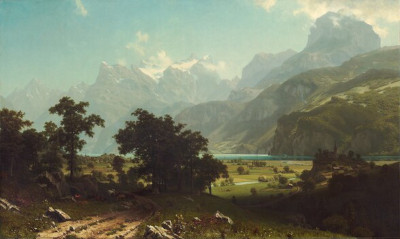Lake Lucerne from 1858 is a delightful landscape painting by Albert Bierstadt. It resides today in the The National Gallery of Art, USA, and is one of their finest contributions in this genre.
This painting is predominantly bright in tone, though the artist does allow a strong contrast in the foreground, through the use of shaded trees which sit either side of a small country lane which slowly snakes its way through the stunning landscape. We can make out bails of hay and smaller clusters of plants dotted across the land in the foreground, as we move towards the lake itself. Naturally, Lake Lucerne is very famous in the art world, and Bierstadt may well have been recommended to visit it by like-minded colleagues. He managed to feature all depths of this environment, with tall mountains jutting up in the far distance. Even those are carefully layered, leading up from the ground to the very top with a smooth transition from one point to the next.
Lake Lucerne itself is relatively brief in this piece, with just a small slither of lake to be seen in the very centre of the piece. Bright white clouds make their way across the sky, though most have been burned away by the hot sun, revealing a large expanse of blue which dominates the upper third of the piece. Several rows of mountains are then filled in with ever lighter tones as we build a sense of perspective, moving from the right hand side of the work towards the very back. Bierstadt was highly knowledgeable of these types of environments and so was able to spot small, intricate details that we mere mortals would probably never have noticed.
Artist Bierstadt travelled to Switzerland as part of his time abroad in the late 1850s. It is believed that he would sketch during this trip, before then completing paintings from the comfort of his own studio, which was a necessary process in the years before mainstream photography appeared. One can therefore track paintings such as this to his notebooks of drawings, and then try to understand how he might tweak an artwork in order to better suit the aesthetic. This particular piece was then sent to New York for sale once he had completed it and the inclusion of this popular region in Europe made it an enticing piece. He would soon become famous within the US and each of his subsequent works was followed with great interest, by both collectors but also the wide public.




